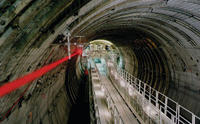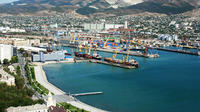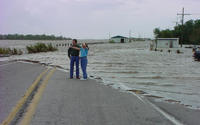-
Climate change and cities: a wake-up call

More than half the world’s population live in cities, many of which are increasingly vulnerable to the impacts of climate change; cities, however, are also emerging as the innovative “first responders” in dealing with climate change; climate change will stress cities in many ways — there will be more heat waves, threatening the health of the elderly and infirm; droughts will also become more commonplace in many cities, while in coastal communities too much water may be the problem, due to sea-level rise and more extreme coastal flooding
-
-
Bacteria designed for sleuthing
Seven Cambridge University undergraduates spent the summer of 2009 genetically engineering bacteria to secrete a variety of colored pigments, visible to the naked eye; they designed standardized sequences of DNA, known as BioBricks, and inserted them into E. coli bacteria — so the bacteria can now change its color to red, yellow, green, blue, brown, or violet; the bacteria can be programmed to do useful things, such as indicate whether drinking water is safe by turning red if they sense a toxin; other uses for the design bacterium include monitoring food additives, patenting issues, personalized medicine, terrorism, and new types of weather
-
-
QinetiQ's OptaSense to protect India's major oil pipeline

The 670 km Mangala Development Pipeline (MDP) is the world’s longest continuously heated and insulated pipeline; it will have access to 75 percent of India’s refining capacity; the company operating it will install QinetiQ’s OptaSense technology to secure the pipeline; OptaSense system is designed to detect, classify, and locate potential threats to buried pipelines
-
-
Glimmer of hope for Yucca Mountain nuclear waste repository project

Over the last twenty-five years, the United States has spent around $15 billion on the Yucca Mountain Nuclear Waste Repository which was supposed to offer a solution to the growing nuclear waste problems at U.S. nuclear power plants; in what some charged was a political move by President Barack Obama to secure Nevada’s Democratic tilt, the administration defunded the project, and funding for work on the site was terminated altogether effective with the 2011 federal budget passed by Congress on 14 April 2011; some in Congress want the project to continue, and the House Appropriations Committee has added $35 million for the project in the 2012 energy spending bill; this is far cry from past appropriations for the project — typically around $400 million a year — and even one of the supporters, Representative Mark Simpson (R-Idaho) described it as symbolic gesture; there is also a case now being heard in federal court, in which the administration is charged with overstepping its bounds by cancelling the project without congressional permission
-
-
Surprise: Thomas Edison also invented the concrete house

Historians say Thomas Edison invented and patented in 1917 an innovative construction system to mass produce prefabricated and seamless concrete houses; most people associate this style of architectural design and type of building technology with the European avant-garde of the early twentieth century; originally motivated by the objective of providing a cost-effective prototype for the working-class home, Edison’s 1917 experiment in mass-production was one of Modernism’s first attempts to construct a building with a single material
-
-
Ports unprepared for increase in Katrina-like storms

A recent report by Stanford University researchers found that the majority of seaports around the world are unprepared for rising sea levels and increasingly violent storms; a majority of ports surveyed listed sea level rise and increasing extreme storms as some of their top concerns; only 6 percent of respondents said they have plans to build hurricane barriers in the next ten years, and less than 18 percent said they had plans to build dikes or other storm protection structures; to ease uncertainty among port authorities, researchers developed a computer model to provide cost estimates that take into account a port’s specific location as well as the cost of labor, materials, and equipment for fortifying a structure against rising sea levels
-
-
Former world leaders say global water crisis must be addressed
In March 2008, the U.K. intelligence services, in a report to then-prime minister Gordon Brown, warned that the deteriorating fresh water situation around the world would soon lead not only to tensions over water between states, but to “water wars”; world leaders, at least former world leaders, agree that the global water situation is dire, and twenty of them, led by Bill Clinton, meet to discuss solutions
-
-
Digital ants protect critical infrastructure
As the U.S. electrical power grid becomes more interconnected through the Internet, the chances of cyber attacks increase as well; a Wake Forest University security expert developed “digital ants” to protect critical networks; unlike traditional security approaches, which are static, digital ants wander through computer networks looking for threats such as computer worms, self-replicating programs designed to steal information or facilitate unauthorized use of computers; when a digital ant detects a threat, it summons an army of ants to converge at that location, drawing the attention of human operators to investigate
-
-
Human impact of rising oceans will extend well beyond coasts

Identifying the human impact of rising sea levels is far more complex than just looking at coastal cities on a map; rather, estimates that are based on current, static population data can greatly misrepresent the true extent — and the pronounced variability — of the human toll of climate change; a new study focuses on four regions identified as highly susceptible to flooding: the tip of the Florida peninsula, coastal South Carolina, the northern New Jersey coastline, and the greater Sacramento region of northern California; the study finds that by 2030, more than nineteen million people will be affected by rising sea levels just in their four study areas
-
-
Germany to scrap nuclear power by 2022

Germany yesterday announced plans to become the first major industrialized power to shut down all its nuclear plants in the wake of the disaster in Japan; phase-out due to be wrapped up by 2022; it means that the country will have to find the 22 percent of its electricity needs currently covered by nuclear reactors from another source; Monday decision is a U-turn for Chancellor Angela Merkel, and means that the current government has adopted the timetable for a nuclear phase-out set by the previous Social Democrat-Green coalition government a decade ago; it also cancels Merkel’s decision from November 2010 to extend the lifetime of Germany’s seventeen reactors by an average of twelve years, which would have kept them open until the mid-2030s
-
-
Making high-speed rail tracks safer

High-speed rail requires prestressed concrete railroad ties, as wooden cross ties are too flexible; for these ties to be effective, prestressing forces must be applied at a considerable distance before the rail load is applied; this is called the transfer length; to resist the heavy impacts the concrete ties utilize about twenty steel wires, each stressed to around 7,000 pounds; if the prestressed force is not properly transferred, failures can occur in the track
-
-
Scientists: bacteria may not have consumed Deepwater Horizon methane
A widely publicized study, published in the prestigious journal Science in January, concluded that a bacterial bloom in the Gulf of Mexico consumed the methane discharged from the Deepwater Horizon well; a new scientific paper casts doubt on that explanation, making the case that uncertainties in the hydrocarbon discharge from the blowout, oxygen depletion fueled by processes other than methane consumption, a problematic interpretation of genetic data, and shortcomings of the model used by the authors of the January study raise serious doubts about the attribution of low oxygen zones to the oxidation of methane gas; the debate has implications for the Gulf of Mexico ecosystem as well as for predictions of the effect of global warming
-
-
New device could help stop one of the world's deadliest killers

A new portable and low cost water sanitation device could help save millions of lives each year; water borne diseases contracted from contaminated water are one of the world’s leading causes of death; each year nearly two million people die, primarily young children, from preventable diseases like diarrhea, cholera, and typhoid from drinking unsafe water; it is estimated that roughly 1.1 billion people lack access to clean water, but all that could potentially change thanks to Torben Frandsen’s LifeStraw; LifeStraw is a 10 inch long straw that is capable of generating 185 gallons of clean water, requires no electricity, and can be cheaply manufactured
-
-
Agreement reached on European Union stress tests
Yesterday European Union officials reached an agreement on the parameters of nuclear stress tests and will soon begin conducting safety reviews at nuclear power plants; the tests will review the resiliency of 143 nuclear facilities in the face of natural disasters like earthquakes and tornadoes in addition to terrorist attacks; the move to conduct safety reviews was triggered by the ongoing nuclear crisis in Japan; events in Japan sparked anti-nuclear protests across Europe and leaders have called for a “comprehensive and transparent risk and safety assessment” at all atomic energy facilities in the European Union
-
-
Senators outline long-term transportation spending plan
On Wednesday, a bipartisan group of senators announced that they had come to an agreement on a long-term transportation spending bill; since 2008, highway and transit construction programs have had an uncertain fate, but the proposed bill would allocate roughly $56 billion a year to highway and transit construction; it is unclear what the final bill will look like as the Senate, House, and executive branch each have diverging views on highway funding; funding the transportation bill will be no small feat; a two year Senate bill would require $12 billion in additional fuel tax revenues and a six year bill would require an addition $70 billion
-
More headlines
The long view
Virtual Models Paving the Way for Advanced Nuclear Reactors
Computer models predict how reactors will behave, helping operators make decisions in real time. The digital twin technology using graph-neural networks may boost nuclear reactor efficiency and reliability.
